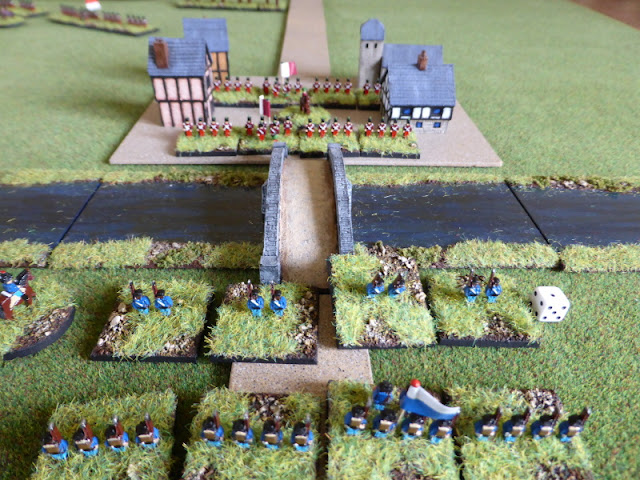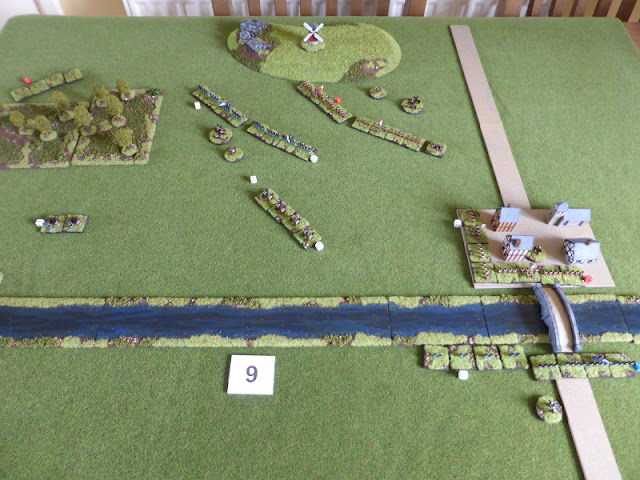After the recent fun game with Post of Honour, I thought it high time to get Honours of War back onto the table as well as working my way through the One Hour Wargames book scenarios. Next in line was Scenario 9 which was inspired by the Battle of Wavre in 1815. I was in two minds as to whether to play this or not to be honest, for a variety of reasons, which I'll address in my post game thoughts. However I decided to give it a go and used the random force generation system from Thomas' Wargaming 19thC Europe. The forces generated were as follows, using the Austrian National Characteristics, with all commanders Dependable:
Red
6 x Line Infantry
1 x Skirmishers
1 x Cavalry
2 x Artillery
Objective
Exit 50% of force off North table edge on the road by game end.
Blue
5 x Infantry
2 x Skirmishers
1 x Cavalry
2 x Artillery
Objective
Control the town and exit 4 units of the North table edge via the road, and/or prevent Red from exiting 50% of its force as per the above.
The Game
With everything set up the day before, it was just a case of finding a spare few hours to play the scenario, which is easier said than done these days! I'll let the photos do the talking and annotate them as required.
 |
| An overview of the table, looking North, with Red defending to the North of the river and Blue beginning to arrive from the Southern table edge. |
 |
| The town garrisoned by an infantry brigade, with the Blue line and light infantry ready to enter the table. |
 |
| The main Blue force, lead by light infantry, ready to move across the bridge. |
 |
| Two Red infantry brigades deployed, with skirmishers in the woods to their right. |
 |
| Blue light infantry come under fire from the town. |
 |
| Red light infantry in the woods and artillery cause more hits on the Blue troops. |
 |
| The Blue light infantry take more hits from the town which causes them to be less effective at firing (3 hits blue die). |
 |
| The light infantry are forced back and need to reform before returning to the fray. At least they have managed to cause the Red infantry in the town to move to a blue die. |
 |
| The Blue troops struggle to make headway, not helped by the early loss of an infantry unit. |
 |
| The light infantry (red die) rout and another infantry unit take hits as they deploy into line. |
 |
| The Blue infantry in front of the town begin to dress their lines to bring more firepower to bear. |
 |
| More deadly fire from the woods sees the loss of an infantry unit. |
 |
| The Blue troops are making little headway against the town defenders. |
 |
| The town defenders have moved one infantry unit to cover the retreat and threat from the Blue infantry across the river. |
 |
| The Blue infantry, cavalry and artillery struggle to deploy. |
 |
| The Red light infantry about to retreat to reform. |
 |
| The reforming Red artillery caught by the Blue infantry and routed. |
 |
| The troops in the town hold on and pose a threat to the Blue right flank across the river. |
 |
| The Red troops lose an infantry unit in the town. |
 |
| The Red troops have an infantry unit near the windmill that will be forced to retreat and reform. |
 |
| The Blue light infantry move into the town and the Red infantry withdraw to form a defensive position across the road out of town. |
 |
| The Blue left wing suddenly under threat. |
 |
| The shooting in the town fails to do any damage. |
 |
| The Blue infantry have to about face to meet the threat from the Red light infantry. |
 |
| The reforming Red infantry. |
End of the Game
At this point the Red force had exited over 50% of their troops and still contested the town, whilst the Blue force realistically couldn't prevent any more Red troops from exiting the table. The Red troops in the town surrendered and were granted the Honours of War.
The Red force had only suffered one infantry unit routed and one surrendered, whilst the Blue force had lost two infantry and one light infantry units routed. Therefore I decided that the Red force had managed a win as they had achieved their objectives and take far fewer losses than Blue.
Post Game Thoughts
First and foremost it was great to be playing 'Honours of War' again and everything came back to me and flowed well, with little recourse to the rulebook, which was great. Also it was nice to get the mdf figures out again, but more on this later. So as mentioned at the start, I had my reservations about this scenario, so without further ado some post game thoughts in no particular order:
- Whilst the scenario might work well for the OHW rules as written, when translating the scenario for other rulesets, problems occur IMHO. Given the deployment options to Red and the units they have to exit off the table, they can simply deploy most of their forces by the hill and behind the woods, which means that for most of the game the Blue troops will be trying to get close enough to them to engage in combat. A token force in the town, backed by artillery, could hold on long enough to delay Blue and/or tie down a significant portion of his force. So in essence to my mind it is virtually impossible for Blue to achieve their objectives and win the game.
- With reference to the above, I chose to deploy Red as if they were defending the crossings and then suddenly received orders to withdraw, to make more of a game of it. It helped but it still didn't feel like a fun scenario to play. In truth i didn't enjoy it, which is unusual.
- Crossing rivers by fords or bridges in the face of an opposing force is always tricky, even with a numerical advantage. With equal forces it is much, much harder. I reckon the attacker needs about a 2:1 advantage to make a game of it.
- I could have deployed my artillery better, either to fire across the river to support the crossing or by the town to shoot the troops onto the objective. Using horse artillery in say the Napoleonic or ACW era might make a difference, but in the SYW with its general lack of mobility, getting a good position early on would have helped.
- The Red light infantry in the woods really helped the Red cause, as they KO'd tow units of Blue infantry, which severely hampered their ability to take the fight to the Red troops.
- Both sides cavalry had little to do, other than for Red to ride off into the sunset or for Blue to struggle to find room to deploy. Again maybe in a Napoleonic game or ACW using them as mounted infantry might have made a difference.
- I made the cover in the town 'light' as otherwise it would have been a nigh on impossible task for the Blue troops to take it, given the assets at their disposal.
- I went for a distinctly 'old school' look to the game, due to a lack of time for something more 'visually pleasing' but also because I like the simple, clean look of 'old school' games.
- Making the Attackers Prussian and the possible advantages of command and movement that this confers on them might have helped, but I wanted to keep things simple for a first game back with HoW. However I think it a good option for future games to go with this and the Austrians as Defenders.
- As with the above, I avoided rolling for commanders this game as I didn't want any 'Dithering' results to unduly affect the game.
So there we have it. Certainly not the best game of late but it certainly helped clarify a few things in my mind as to what makes for a good game, whether balanced or not. I think this scenario could work well with some tweaks as outlined above, but maybe something to revisit sometime in the future.
Moving on I have ordered some more reinforcements from Walt at Commission Figurines, so that I can field Light and Heavy Cavalry, as well as some Grenadiers who will count as Superior Infantry. Originally these figures were meant to be a stop gap to allow me to play games until such time as I'd be able to paint up 'proper' armies for a conflict. However I have grown to love these, hence the extras just ordered.
A recent reply on Jon Freitag's excellent Blog about 'Generational Capacity' has got me to a thinking since I read it. It has given me plenty to ponder over and may even generate its own post in the future. In the meantime I'm not sure what will grace the table next, but until then, given the recent news re: the Omicron variant, stay safe and keep healthy!












































